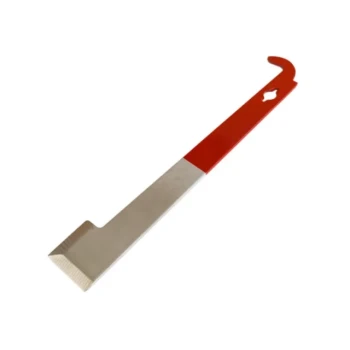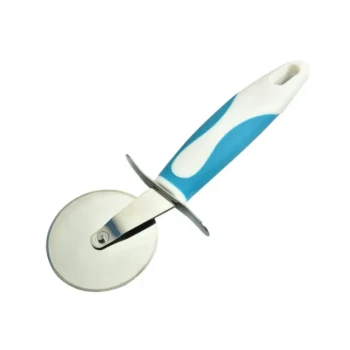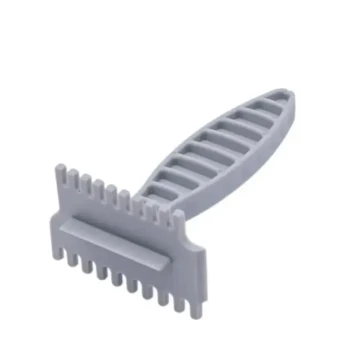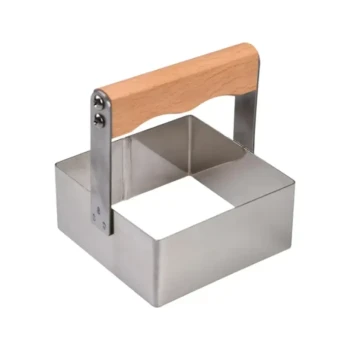The essential components of beekeeping protective clothing are the veil, the suit or jacket, gloves, and proper footwear. These pieces work together to create a crucial barrier between you and the bees, protecting sensitive areas and allowing you to work with your hives safely and confidently.
While a full suit offers maximum coverage, the non-negotiable foundation of all beekeeping safety is a high-quality hat and veil. Protecting your head, face, and neck is the single most important step in preventing serious stings.

The Core Components of Protection
Each piece of gear serves a specific and vital purpose. Understanding the function of each component helps you make informed decisions about your safety.
The Veil: Your Most Critical Defense
The hat and veil are universally considered the most important pieces of protective equipment. They shield your face, eyes, and neck—the areas most sensitive to stings and most critical to protect.
A good veil is typically attached to a wide-brimmed hat, ensuring the mesh netting is held away from your skin, even when you bend and move.
The Suit or Jacket: Full Body Coverage
This is the main barrier for your torso and limbs. You have two primary options: a full, one-piece suit (coveralls) or a jacket.
A full suit offers seamless protection from your neck to your ankles, eliminating any gaps where bees could enter. A jacket provides excellent upper-body protection and is often quicker to put on for brief inspections.
Gloves: Protecting Your Hands
Gloves protect your hands, which are in direct contact with the hive components. They prevent stings while you manipulate frames and perform other tasks.
Options range from thick leather for maximum protection to thinner nitrile gloves that offer greater dexterity for more delicate work.
Footwear and Pants: Securing the Lower Body
Your lower body requires just as much attention as your upper body. Always wear sturdy, closed-toe boots or shoes.
Pair them with thick, heavy-duty pants like denim jeans or canvas painter's pants. To prevent bees from crawling up your legs, tuck your pants into your socks or use boot bands to secure them.
Choosing Your Level of Protection
The gear you choose depends on your experience level, the temperament of your bees, and your personal comfort with the risk of being stung.
The Full Suit: Maximum Security
A full, one-piece suit provides the most comprehensive protection. This is the recommended choice for beginners.
The complete coverage offers peace of mind, allowing you to focus on learning bee behavior and hive management without the distraction of worrying about stings.
The Jacket and Veil Combo: A Balance of Safety and Comfort
More experienced beekeepers, or those doing quick hive checks, may opt for a jacket and veil combination.
This setup is often cooler in warm weather and allows for more mobility. However, it requires careful attention to the clothing you wear on your lower body to ensure there are no gaps.
What to Wear Underneath
Your protective suit is a barrier, not armor. Always wear clothing underneath, preferably a long-sleeved shirt and long pants. The extra layer provides additional space between the suit and your skin, making it harder for a bee's stinger to reach you.
Understanding the Trade-offs
Choosing your gear involves balancing competing priorities. There is no single "best" setup for everyone.
Protection vs. Dexterity
Thicker materials and heavy leather gloves offer the highest level of sting prevention. However, they can be cumbersome and reduce your fine motor skills, making it harder to handle frames gently.
Lighter gear improves dexterity and your "feel" for the hive, but at the cost of reduced protection.
Security vs. Comfort
A full bee suit can become extremely hot and restrictive, especially during summer inspections. This discomfort can lead to fatigue and rushed work.
A jacket is cooler and less confining, but it introduces a potential entry point for bees at your waist if you are not careful.
The Beginner's Imperative
As you gain experience, you will learn the temperament of your specific bees and your own tolerance for stings.
However, when you are starting out, the trade-off should always favor more protection. Confidence is key to calm and effective hive management.
Maintaining Your Gear for Long-Term Safety
Your protective clothing is only effective if it's in good condition. Regular maintenance is a critical aspect of apiary safety.
Regular Inspections
Before every hive visit, carefully inspect your suit, veil, and gloves for any holes or tears. Pay close attention to zippers and Velcro closures to ensure they seal completely. A small opening is all a determined bee needs.
Proper Cleaning and Care
Most bee suits and gloves can be machine washed, but it is best to hang them to dry to prevent shrinkage.
Hats and veils, however, should be hand-washed gently in warm, soapy water. Machine washing can damage the delicate mesh netting, compromising its effectiveness.
Making the Right Choice for Your Goal
Select your gear based on a realistic assessment of your needs and experience level.
- If your primary focus is maximum safety and peace of mind (especially as a beginner): Choose a full, one-piece bee suit to ensure there are no gaps in your coverage.
- If your primary focus is comfort and mobility for quick inspections: A high-quality jacket and veil combination paired with thick, well-secured pants may be sufficient.
- Regardless of your choice: Always prioritize a well-maintained, secure veil, as it protects your most vulnerable and sensitive areas.
Proper protective gear transforms beekeeping from a source of anxiety into a focused and rewarding experience.
Summary Table:
| Component | Primary Function | Key Considerations |
|---|---|---|
| Veil | Protects face, eyes, and neck | Most critical piece; mesh should be away from skin |
| Suit/Jacket | Covers torso and limbs | Full suit for max coverage; jacket for mobility |
| Gloves | Shields hands during hive manipulation | Trade-off between protection (leather) and dexterity (nitrile) |
| Footwear & Pants | Secures lower body | Closed-toe boots; pants tucked into socks to prevent entry |
Ready to Outfit Your Apiary with Confidence?
As a commercial beekeeper or distributor, your safety and efficiency are paramount. HONESTBEE supplies durable, high-quality beekeeping protective clothing and equipment designed for the demands of professional apiaries. We help you protect your most valuable asset—your people—so you can focus on managing your hives productively.
Contact HONESTBEE today to discuss your wholesale needs and get the right gear for your operation.
Visual Guide
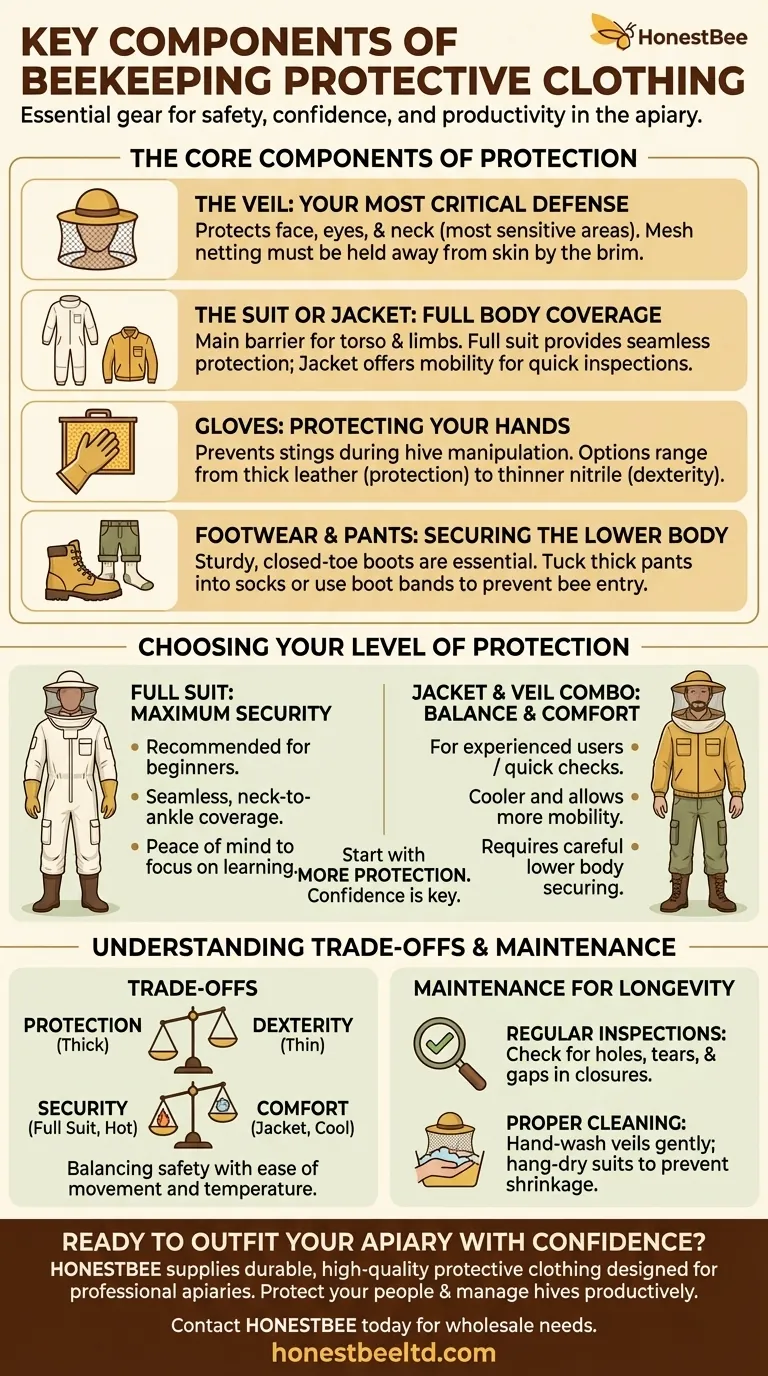
Related Products
- 3 Layer Mesh Vented Sting Proof Beekeeping Suit with Hat and Veil
- Cotton Beekeeping Suit and Round Hat with Veil Bee Keeper Protective Gear
- Vented Beekeeping Jacket with Hood and Veil for Beekeepers
- Heavy Duty Cowboy Beekeeper Hat with Visibility Veil Outdoor Professional Beekeeping Protective Gear
- Beekeeper Cowboy Hat and Veil for Beekeeping
People Also Ask
- What are the key features of the 3-layer mesh gear designed for beekeeping? Superior Protection & Ventilation
- What should be considered regarding the color of beekeeping clothing? Ensure Your Safety and Keep Bees Calm
- Why do beekeepers wear suits? Essential Protection for Hive Management
- What are the advantages of reinforced stitching and durable zippers in beekeeping suits? Ensure Maximum Safety & Longevity
- What should be worn under beekeeping protective clothing? Maximize Your Safety with the Right Base Layer














